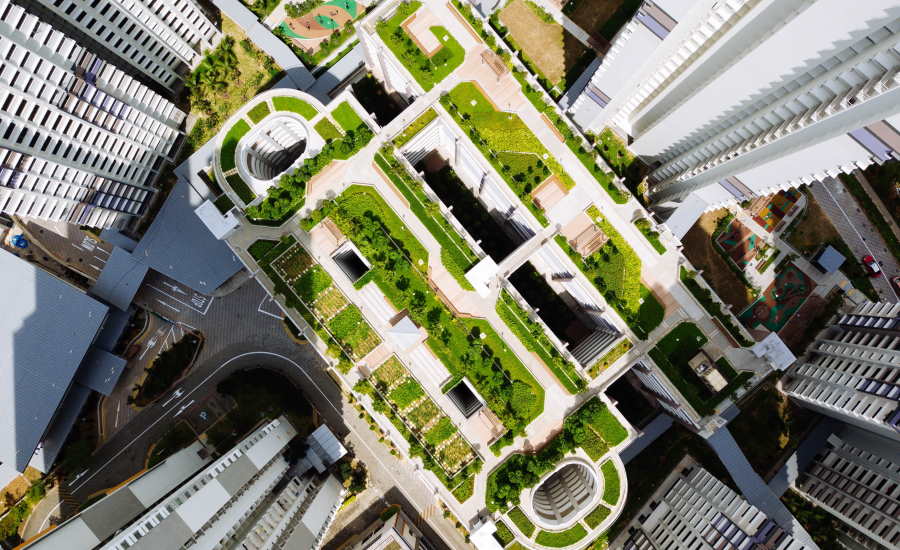Using Switchgrass for Green Roofs and Biofuel

Photo by CHUTTERSNAP on Unsplash.
Look around any big city and you may see a green fringe on the rooftops. Many homes and businesses have begun adding plant life to their buildings in the form of green roofs. However, this concept works not only in urban areas but also in rural and suburban regions.
Experts categorize green roofs into three types: extensive, intensive, and semi-intensive. In general, an extensive green roof has a limited variety of plants and shallow growth, often less than 6 inches, and it may not be accessible to people. An intensive green roof boasts a diverse selection of plants (even including smaller trees), a deeper growth, and more accessibility to building patrons and residents. A semi-intensive green roof is a combination of the other two types.
The Benefits of Green Roofs
Around the United States and the world, green roofs, also known as living roofs, have specific advantages: These plant-covered structures reduce heat and help insulate buildings, thus lowering energy costs. They improve air quality, lessen greenhouse gas emissions, and increase the efficiency of HVAC and other mechanical equipment. Due to these energy-related benefits, buildings with green roofs often see an increase in their Leadership in Energy and Environmental Design (LEED) credits.
Green roofs are known to help with noise reduction; some studies report a decrease of 40 to 50 decibels. They also help protect roofing materials, which results in fewer repairs and longer roof life.
For larger buildings, an accessible green roof provides an inviting green space for residents to enjoy. They can use the area for social gatherings, herb and vegetable gardens, and protected areas for butterflies and birds. For these reasons, green roofs can make a building more attractive and marketable for many demographics.
The Evolution of Living Roofs
Experts say that green roofs originated in Scandinavia, and they have been common in Asia and Europe for some time. In Europe today, the green roofing industry receives financial support from the government, while in North America, the idea of using green roofs is still evolving. However, with increased interest in combatting climate change, interest will likely grow.
Early versions of green roofs were made only of turf. This material kept homes cooler in the summer and warmer in the winter, as well as dry all year round. In recent years, green roof enthusiasts have adopted many varieties of plants for their projects, including wildflowers.
Considering Switchgrass
Here is another material to consider: switchgrass. This unassuming perennial bunchgrass is easy to grow, and as an added benefit, building owners can harvest it for biofuel.
Switchgrass can thrive in a wide range of environments. You might see it growing in clay or sand prairies, in open woodlands, on sand dunes and savannas, on the edges of marshes and banks of rivers, and along railroads, roadsides, and fields. Before long, you might also see it growing on rooftops.
This grass performs best in well-drained soil with a pH of 5.5 to 7.0. When planting, be sure to use a depth of half to three-quarters inch in a well-prepared seedbed, with a seeding rate of 6 to 7 pounds. There are several plant varieties, so it is critical to use the type most suited to your hardiness zone.
Similar to other native warm-season grasses, switchgrass needs to be exposed to moist, cold conditions before it will germinate. To accomplish that, be sure to plant seeds before the last frost.
Note that switchgrass may need two to three growing seasons to become fully established. Few pests pose a threat to switchgrass, but it is susceptible to weeds, and it can survive for 10 or more years.
Switchgrass can grow to be as tall as 3 to 5 feet (or even higher). Bear that in mind, depending on the type of building you are targeting. This willowy grass might not seem appropriate for a chrome-and-glass financial institution, but it might be perfect for a farm-to-table restaurant or a renovated warehouse space.
Biofuel Source
In addition to cooling and protecting your roof, many experts see switchgrass as a promising biofuel. Once harvested, switchgrass can contribute to ethanol production, heat our homes and offices, and help create electricity.
Biofuels are a climate-friendly alternative to fossil fuels. While fossil fuels are limited supplies of organic matter buried underground for millions of years, biofuels depend only on plants that are readily available now and in the future. When we burn fossil fuels, we add carbon dioxide to our atmosphere, which is unhealthy for our planet. In contrast, using biofuels releases only as much carbon dioxide as the plants absorbed while they were living.
Switchgrass is an intriguing biofuel option because it can grow in areas where other crops cannot. According to some studies, switchgrass can yield five times more energy than is needed to produce it. That is much higher than the energy output of other biofuel sources, such as corn.
Because it takes two to three seasons for switchgrass to establish fully, growers should not harvest it for the first three years. After that point, experts suggest harvesting switchgrass once a year, after a frost, so some nutrients return to the roots. The initial lag in harvest will mean more upfront costs, but with a 10-year plan, switchgrass can prove to be not only an innovative energy saver but also a valued energy producer.
Plant-Based Partnerships
Some experts believe that renewable energy sources such as switchgrass can help reduce our dependency on the earth’s limited fossil fuel supply. Also, many builders see green roofs as a way to protect our natural environment and lower energy costs. By considering a green roof that grows a biofuel source, both builders and consumers can feel good about doing their part in improving our planet.
So will we see future partnerships between the roof construction and biofuel industries? Perhaps. If enough roof builders are willing to incorporate switchgrass or other plants into their projects, if customers are willing to try this approach, and if biofuel producers get on board, everyone can benefit.
Disclaimer: The information contained in this article is for general educational information only. This information does not constitute legal advice, is not intended to constitute legal advice, nor should it be relied upon as legal advice for your specific factual pattern or situation.
Looking for a reprint of this article?
From high-res PDFs to custom plaques, order your copy today!






